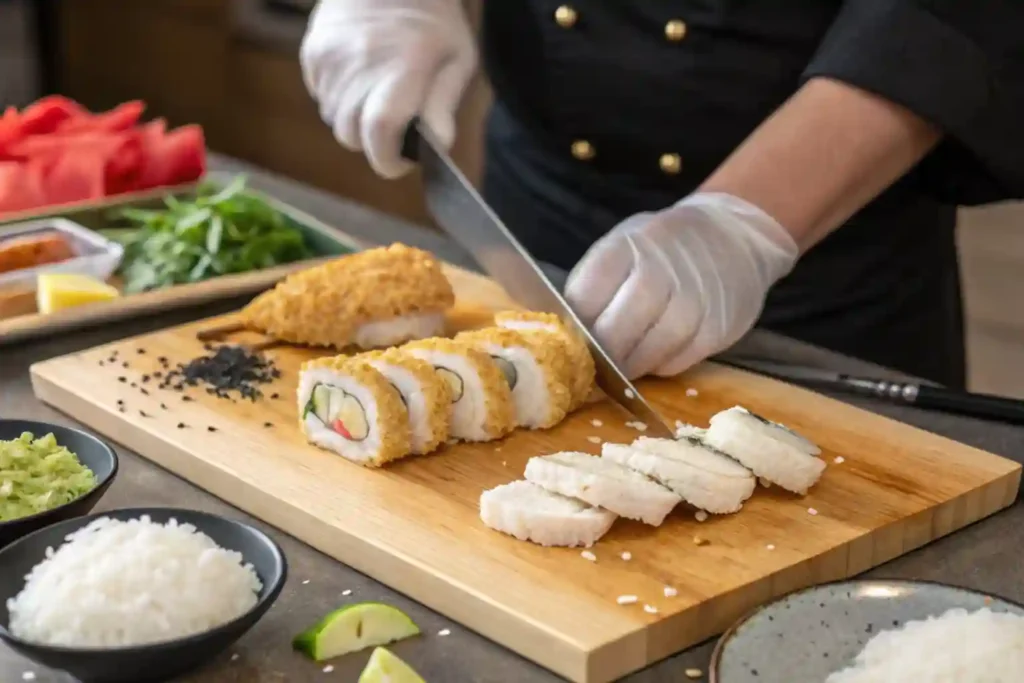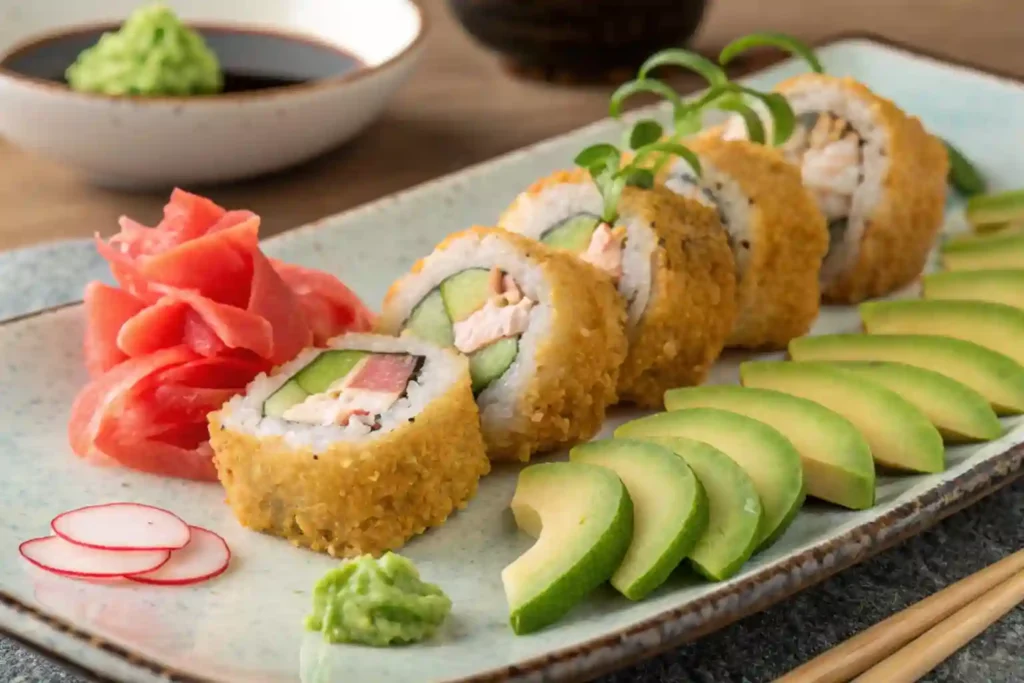
Table of contents
1. What is Chicken Tempura Roll Made Of?
The chicken tempura roll is a delightful fusion of flavors and textures, combining the crispy goodness of tempura with the traditional elements of sushi. Understanding what goes into this delicious dish is essential for any sushi enthusiast looking to recreate it at home.
Ingredients Overview
A classic chicken tempura roll typically consists of the following key ingredients:
- Chicken: The star of the dish, usually boneless chicken breast or thigh, cut into strips.
- Tempura Batter: A light and airy batter made from flour, cornstarch, and cold water, which gives the chicken its signature crunch.
- Sushi Rice: Short-grain rice seasoned with rice vinegar, sugar, and salt, providing a sticky base for the roll.
- Nori (Seaweed): Sheets of dried seaweed that hold the roll together and add a unique flavor.
Preparation of Chicken
To prepare the chicken for your tempura roll, follow these steps:
- Choose the Right Cut: Opt for boneless chicken breast or thigh for tenderness.
- Cut into Strips: Slice the chicken into thin strips, about 1 inch wide, to ensure even cooking.
- Marinate (Optional): For added flavor, marinate the chicken in soy sauce, garlic, and ginger for 30 minutes before cooking.
Sushi Rice Preparation
The foundation of any sushi roll is the rice. Here’s how to prepare it:
- Rinse the Rice: Wash 2 cups of sushi rice under cold water until the water runs clear to remove excess starch.
- Cook the Rice: Use a rice cooker or stovetop method to cook the rice with 2.5 cups of water. Let it sit for 10 minutes after cooking.
- Season the Rice: In a small bowl, mix 1/4 cup rice vinegar, 2 tablespoons sugar, and 1 teaspoon salt. Gently fold this mixture into the warm rice, being careful not to mash the grains.
Additional Fillings
While the chicken is the main attraction, you can enhance your tempura roll with additional fillings:
- Avocado: Adds creaminess and balances the crunch of the tempura.
- Cucumber: Provides a refreshing crunch and a burst of flavor.
- Carrots: Thinly sliced carrots can add color and sweetness to the roll.
2. What Does a Tempura Roll Have in It?

A tempura roll is not just about the chicken; it’s a harmonious blend of various ingredients that come together to create a delightful sushi experience. Understanding what goes into a tempura roll will help you appreciate its complexity and flavor.
Core Ingredients
The essential components of a tempura roll include:
- Tempura Chicken: The main filling, which is crispy and flavorful.
- Sushi Rice: The sticky base that holds the roll together.
- Nori: The seaweed wrap that encases the fillings.
- Vegetables: Common additions include avocado, cucumber, and sometimes even pickled vegetables for added flavor.
Flavor Enhancers
To elevate the taste of your tempura roll, consider these flavor enhancers:
- Soy Sauce: A classic dipping sauce that complements the savory flavors of the roll.
- Wasabi: Adds a spicy kick that pairs well with the richness of the tempura.
- Pickled Ginger: A palate cleanser that refreshes the taste buds between bites.
Variations
While the traditional chicken tempura roll is delicious, there are many variations to explore:
- Shrimp Tempura Roll: Substitute chicken with shrimp for a different flavor profile.
- Vegetable Tempura Roll: Use a mix of tempura-fried vegetables like sweet potatoes and zucchini for a vegetarian option.
- Spicy Chicken Tempura Roll: Add spicy mayo or sriracha for a kick.
Serving Suggestions
To make your chicken tempura roll experience even better, consider these serving suggestions:
- Side Dishes: Pair your roll with miso soup or a simple salad for a complete meal.
- Beverages: Enjoy with green tea, sake, or a light beer to complement the flavors.
- Presentation: Serve on a wooden sushi board with garnishes like sesame seeds and microgreens for an appealing look.
3. Where is Tempura Chicken From?

Tempura is a beloved dish that has its roots in Japanese cuisine, but its history is quite fascinating and reflects a blend of cultural influences.
Historical Background
- Origins in Portugal: Tempura is believed to have been introduced to Japan by Portuguese missionaries in the 16th century. The technique of frying food in batter was adapted by the Japanese, leading to the creation of tempura as we know it today.
- Evolution in Japan: Over time, tempura became a popular street food in Japan, especially during the Edo period (1603-1868). It was often served with rice and dipping sauces, making it a staple in Japanese households.
Cultural Significance
- Popularity in Japan: Tempura is not just a dish; it’s a culinary art form in Japan. Chefs take great pride in their tempura-making skills, focusing on achieving the perfect batter and frying technique.
- Global Influence: Today, tempura has transcended its Japanese origins and is enjoyed worldwide. Many sushi restaurants feature tempura rolls on their menus, showcasing the dish’s versatility.
Regional Variations
- Japanese Variations: In Japan, you can find various types of tempura, including seafood, vegetables, and even unique ingredients like mushrooms and eggplant.
- International Adaptations: Different countries have put their spin on tempura. For example, in the United States, you might find tempura-fried items served with unique sauces or incorporated into fusion dishes.
Modern Interpretations
- Healthier Options: With the rise of health-conscious eating, some chefs are experimenting with alternative frying methods, such as air frying, to create lighter versions of tempura.
- Creative Fillings: Modern sushi chefs are also getting creative with fillings, incorporating ingredients like spicy tuna or cream cheese into tempura rolls.
4. How Do You Eat Tempura Chicken?
Eating tempura chicken, especially when it’s part of a sushi roll, can be a delightful experience. Here’s how to enjoy it to the fullest.
Serving Style
- Presentation
- Chefs often serve tempura chicken in a sushi roll, but you can also enjoy it as a standalone dish. When they serve it as a roll, they typically slice it into bite-sized pieces for easy eating.
- Accompaniments: Tempura chicken is usually accompanied by dipping sauces, such as soy sauce or tentsuyu (a dipping sauce made from dashi, soy sauce, and mirin).
Eating Etiquette
- Using Chopsticks: In traditional Japanese dining, it’s common to use chopsticks to eat sushi. If you’re not comfortable with chopsticks, it’s perfectly acceptable to use your hands.
- Dipping Technique: When dipping your tempura roll, avoid submerging it completely in the sauce. Instead, dip just the end of the roll to prevent the rice from becoming too soggy.
Pairing Suggestions
- Beverages: Pair your tempura chicken roll with green tea, sake, or a light beer to enhance the flavors. The refreshing taste of green tea complements the richness of the tempura.
- Side Dishes: Consider serving your tempura roll with a side of miso soup or a simple salad to create a balanced meal.
Dipping Techniques
- Soy Sauce: A classic choice, soy sauce adds a savory depth to the tempura roll. You can also mix in a bit of wasabi for an extra kick.
- Tentsuyu: This traditional dipping sauce enhances the flavor of tempura. It’s made from dashi, soy sauce, and mirin, providing a slightly sweet and umami-rich taste.
5. What is the Difference Between Battered and Tempura?
Understanding the distinction between battered and tempura preparations is essential for any cooking enthusiast, especially when it comes to making delicious rolls.
Battering Techniques
- Traditional Battering
- Cooks typically coat battered foods in a thick mixture of flour, water, and sometimes eggs. This process results in a denser coating that feels heavier and greasier.
- Tempura Batter
- In contrast, chefs prepare tempura batter using a lighter mixture of flour, cornstarch, and ice-cold water. This method creates a delicate, airy coating that crisps up beautifully when fried.
Texture and Flavor
- Battered foods tend to have a heavier texture and absorb more oil during frying, which leads to a richer flavor but also results in a greasier finish.
- Chefs prepare tempura to achieve a light and crispy texture. The quick frying method and the use of cold water in the batter help create a crunch that feels less oily and more refined.
Cooking Methods
- Frying Temperature
- Chefs typically fry tempura at a higher temperature (around 350°F to 375°F) for a shorter period. This method helps seal in moisture and creates a crispy exterior.
- Battered Foods
- Cooks often prepare battered items at lower temperatures for longer periods. This approach can lead to a heavier texture and increased oil absorption.
Nutritional Aspects
- Health Considerations: Tempura is often considered a lighter option compared to traditional battered foods. The use of less batter and the quick frying method can result in fewer calories and less fat, making it a more health-conscious choice.
6. Is Tempura Chicken Already Cooked?
When it comes to tempura chicken, understanding its cooking process is crucial for food safety and enjoyment.
Cooking Process
- Preparation: Tempura chicken is made by coating raw chicken strips in tempura batter and then frying them until golden brown. This process cooks the chicken thoroughly.
- Cooking Time: The frying time for tempura chicken is typically short, around 3 to 5 minutes, depending on the thickness of the chicken strips. This quick cooking method helps retain moisture and flavor.
Safety Considerations
- Internal Temperature: To ensure that tempura chicken is safe to eat, it should reach an internal temperature of 165°F (75°C). Using a meat thermometer can help confirm this.
- Visual Cues: Properly cooked tempura chicken should be golden brown on the outside and no longer pink in the center.
Storage Tips
- Refrigeration: If you have leftover tempura chicken, store it in an airtight container in the refrigerator. It’s best consumed within 2 to 3 days.
- Freezing: For longer storage, you can freeze cooked tempura chicken. Wrap it tightly in plastic wrap and place it in a freezer-safe bag. It can last for up to 3 months.
Reheating Methods
- Oven: To reheat tempura chicken, preheat your oven to 350°F (175°C) and place the chicken on a baking sheet. Heat for about 10-15 minutes until warmed through and crispy.
- Air Fryer: An air fryer is an excellent option for reheating tempura chicken, as it helps restore the crispiness. Heat at 350°F (175°C) for about 5-7 minutes.
7. Conclusion and FAQs
In conclusion, the chicken tempura roll is a delightful dish that combines the crispy texture of tempura with the traditional elements of sushi. With its rich history, cultural significance, and delicious flavor, it’s a must-try for any sushi enthusiast. Whether you’re making it at home or enjoying it at a restaurant, understanding the components and preparation methods will enhance your experience.
For those interested in exploring more about healthy eating, you might find the article on Is Indian Food Healthy? insightful. If you’re looking for convenient meal options, check out Healthy Choice Frozen Meals. And for those who enjoy experimenting with flavors, consider exploring Smoker Recipes: Best Foods, Tips & Quick Ideas to complement your culinary adventures.
FAQs
- What is chicken tempura roll made of?
- A chicken tempura roll is made of tempura-fried chicken, sushi rice, nori (seaweed), and often includes additional fillings like avocado and cucumber.
- What does a tempura roll have in it?
- A tempura roll typically contains tempura-fried ingredients (like chicken or shrimp), sushi rice, nori, and may be accompanied by dipping sauces like soy sauce or wasabi.
- Where is tempura chicken from?
- Tempura chicken has its origins in Japan, influenced by Portuguese cooking techniques introduced in the 16th century.
- How do you eat tempura chicken?
- Tempura chicken can be eaten as part of a sushi roll or on its own, typically dipped in soy sauce or tentsuyu. It can be enjoyed with chopsticks or by hand.
- What is the difference between battered and tempura?
- The main difference lies in the batter: tempura batter is lighter and crispier, while traditional batter is thicker and denser.
- Is tempura chicken already cooked?
- Yes, tempura chicken is cooked by frying raw chicken strips in tempura batter until they reach an internal temperature of 165°F (75°C).
